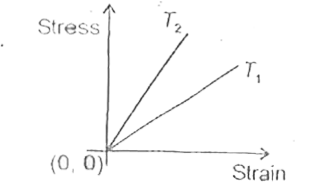A
B
C
D
Text Solution
Verified by Experts
|
Topper's Solved these Questions
MECHANICAL PROPERTIES OF SOLIDS
AAKASH INSTITUTE|Exercise Assignment(Section-B)|24 VideosView PlaylistMECHANICAL PROPERTIES OF SOLIDS
AAKASH INSTITUTE|Exercise Assignment(Section-C)|28 VideosView PlaylistMECHANICAL PROPERTIES OF SOLIDS
AAKASH INSTITUTE|Exercise EXERCISE|19 VideosView PlaylistMECHANICAL PROPERTIES OF FLUIDS
AAKASH INSTITUTE|Exercise SECTION - J|9 VideosView PlaylistMock test 03
AAKASH INSTITUTE|Exercise EXAMPLE|37 VideosView Playlist
Similar Questions
Explore conceptually related problems
Knowledge Check
A
B
C
D
Submit
A
B
C
D
Submit
A
B
C
D
Submit
Similar Questions
Explore conceptually related problems
AAKASH INSTITUTE-MECHANICAL PROPERTIES OF SOLIDS-Assignment(Section-A)
- The length of wire, when M(1) is hung from it, is l(1) and is l(2) wit...
04:43
|
Play - When a load of 10 kg is suspended on a metallic wire, its length incre...
02:14
|
Play - A rod of length / and radius r is held between two rigid walls so that...
04:08
|
Play - If the temperature of a wire of length 2 m and area of cross-section 1...
03:49
|
Play - The energy stored per unit volume of a strained wire is
01:49
|
Play - A wire suspended vertically from one of the its ends is stretched by a...
02:36
|
Play - Work done by restoring force in a string within elastic limit is -10 J...
03:23
|
Play - The work done per unit volume to stretch the length of area of cross-s...
04:36
|
Play - Which of the following affects the elasticity of a substance
01:27
|
Play - Select the wrong definition
05:55
|
Play - Figure shows graph between stress and strain for a uniform wire at wo ...
03:43
|
Playing Now - Two different types of rubber are found to have the stress-strain curv...
04:00
|
Play - The ratio of adiabatic to isothermal elasticity of a diatomic gas is
07:22
|
Play - A uniform cube is subjected to volume compression. If each side is dec...
01:02
|
Play - When a rubber ball is taken to the bottom of a sea o depth 1400 m ts v...
04:11
|
Play - A spherical ball contracts in volume by 0.02%, when subjected to a nor...
02:51
|
Play - A steel plate of face area 4 cm^2 and thickness 0.5 cm is fixed rigidl...
05:23
|
Play - The poisson's ratio cannot have the value
02:07
|
Play - A material has Poisson's ratio 0.5, If a uniform rod of it suffers a ...
01:39
|
Play - When a uniform metallic wire is stretched the lateral strain produced ...
04:31
|
Play
